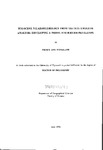Holocene palaeohydrology from testate amoebae analysis: developing a model for British peatlands
| dc.contributor.author | Woodland, Wendy Ann | |
| dc.contributor.other | School of Geography, Earth and Environmental Sciences | en_US |
| dc.date.accessioned | 2013-09-18T12:00:54Z | |
| dc.date.available | 2013-09-18T12:00:54Z | |
| dc.date.issued | 1996 | |
| dc.identifier | NOT AVAILABLE | en_US |
| dc.identifier.uri | http://hdl.handle.net/10026.1/1851 | |
| dc.description | Merged with duplicate record 10026.1/841 on 27.03.2017 by CS (TIS) | |
| dc.description.abstract |
Testate amoebae (Protozoa: Rhizopoda) are particularly abundant in peatlands. Previous studies have used testate amoebae in palaeoenvironmental studies, but have used qualitative data only, so that results are expressed only in terms of 'wet', 'dry' or 'moist'. This study uses testate amoebae to derive quantitative reconstructions of mire surface wetness for part of the Holocene and is split into two parts. The first part of this study modelled the responses of individual testate amoebae species to environmental variables on ombrotrophic mires, since the peatland-climate link makes these habitats the one of the most useful in palaeoclimate reconstructions. 163 samples of modern testate amoebae faunas were obtained from 9 ombrotrophic mires across Britain. Environmental variables (mean annual water table, moisture content, dissolved organic carbon, pH, Ca^*, Mg^*, SO^^', CI", conductivity and host plant species) were measured. A hydrological monitoring programme on an ombrotrophic mire on Dartmoor provided a detailed record of hydrology and selected water chemistry over a year and identified the season most representative of mean annual environmental conditions. Weighted averaging regression applied to the faunas provided absolute moisture content and mean annual water table optima for 38 common testate amoebae species. In the second part of the study weighted averaging calibration was used to derive transfer functions from the modern species' optima. From these, mean annual water table and substrate moisture content were reconstructed for the top 100 cm of a selected fossil peat core from Bolton Fell Moss, Cumbria. These reconstructions were compared with those derived from plant macrofossil and peat humification analyses. Testate amoebae provided a further insight into the decline of Sphagnum imbricatum, clarified noisy areas of the existing palaeohydrological record and suggested that hydrological changes at Bolton Fell Moss were likely to have been gradual, rather than the sudden event implied by the plant macrofossil record. This study demonstrates the future potential of testate amoebae as palaeohydrological indicators. Expansion of the modem data set in terms of species composition and geographical extent, further applications of testate amoebae into multi-proxy palaeohydrological reconstructions and taxonomic refinements are suggested to improve the technique further. | en_US |
| dc.language.iso | en | en_US |
| dc.publisher | University of Plymouth | en_US |
| dc.title | Holocene palaeohydrology from testate amoebae analysis: developing a model for British peatlands | en_US |
| dc.type | Thesis | |
| plymouth.version | Full version | en_US |
| dc.identifier.doi | http://dx.doi.org/10.24382/4854 | |
| dc.identifier.doi | http://dx.doi.org/10.24382/4854 |
Files in this item
This item appears in the following Collection(s)
-
01 Research Theses Main Collection
Research Theses Main


